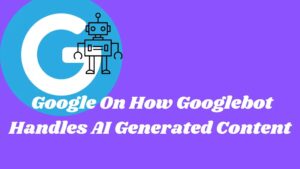Martin Splitt from Google responds to a query on indexing, rendering, and handling AI content.
When asked about how Googlebot was adapting its crawling and rendering to the surge in AI-generated content, Martin Splitt from Google responded.
Martin’s response shed light on Google’s handling of AI-generated material and the function of quality control.
Rendering of a webpage by Googlebot
The process of building a webpage in a browser by downloading the HTML, pictures, CSS, and JavaScript, then assembling them into a webpage, is known as page rendering.
In order to render the webpage, Google’s crawler Googlebot also downloads the HTML, pictures, CSS, and JavaScript files.
How Google Handles Content Produced by AI
Martin’s remarks were made in the context of a Duda-produced webinar titled “Exploring the Art of Rendering with Google’s Martin Splitt.”
One audience member questioned whether Google’s capacity to render sites at the point of crawling was impacted by the substantial amount of AI material.
Martin gave an explanation, but he also provided details on how Google determines whether a webpage is of low quality at the moment it is being crawled and what it does afterwards.
Ulrika Viberg read the query that Ammon Johns posed.
The query is as follows:
“So, we also have one from Ammon, and this is a subject that is frequently discussed.
I often witness it.
They said that as a result of AI, content generation has increased, placing an increased burden on crawling and rendering.
Is it probable that rendering procedures may need to be streamlined?
Ammon appears to be curious as to whether any extra procedures are being carried out in response to the AI material in order to manage the heightened crawling and rendering load.
Martin Splitt’s response was:
My best estimate is that, thus I don’t believe that.
Martin then addresses the glaring problem with AI content that SEOs are curious about: spotting it.
Martin went on to say:
Therefore, we perform quality detection or quality control at several levels, and the majority of pornographic content doesn’t necessarily require JavaScript to demonstrate its pornographic nature.
So what’s the point of rendering if we already know it is s****y content?
If we decide, “Okay, this looks like absolute crap, and the JavaScript might just add more crap, then bye.”
If the page is blank, we can say, “We don’t know.”
Let’s at least attempt to render as people typically don’t add empty pages here.
Then, when the rendered results are poor, we say, “Okay, fair enough, this has been poor.”
Therefore, this has already occurred. This is not a novel concept.
AI might make things bigger, but it doesn’t really alter anything. The perpetrator in this case is not rendering.
AI Uses Quality Detection
Martin Splitt omitted mentioning the use of AI detection on the content by Google.
He claimed that Quality Detection was used by Google at various stages.
Because low quality AI material can also be detected by a quality detection algorithm, Search Engine Journal released an article about it, this is quite interesting.
Finding low-quality machine-generated content was not the algorithm’s intended use. But they found that the algorithm had found it on its own.
Much of this algorithm is in line with what Google said about their approach for identifying helpful information that was created by individuals, which was announced at the same time.
Regarding the Helpful Content algorithm, Danny Sullivan wrote:
We’re introducing a number of changes to Search to make it simpler for users to locate valuable material created by and for people.
However, he didn’t reference human-written content merely once. It was cited three times in his article announcing the Helpful Content method.
The algorithm was created to identify machine-generated content and, more generally, low-quality information.
Generative Models are Unsupervised Predictors of Page Quality: A Colossal-Scale Study is the title of the research study.
The researchers note the following:
This study suggests that detectors trained to distinguish between human and machine-written text are superior over supervised spam classifiers as language quality predictions for webpages.
Referring to what Martin Splitt mentioned earlier:
“…at various phases, we perform quality detection or quality control…
Therefore, this has already occurred. This is not a novel concept.
AI might make things bigger, but it doesn’t really alter anything.
Martin appears to be stating that:
- Nothing new is being used for AI content.
- Google employs quality control for both manual and automated content.

